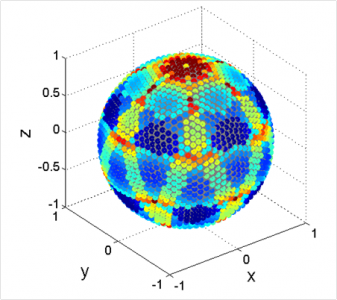MXL seeks fundamental research advancements to enable bold flight to the extremes. Given our emphasis on flight, our research tends to focus on systems issues, that is where problems and solutions are found when considering the entire vehicle or mission. Our major efforts are listed and summarized below.
- Pervasive networking of space assets
- Optimization of space system design and operations
- Machine learning techniques for autonomous orbit determination and health assessment
- Multi modal sensor fusion
Pervasive Networking of Space Assets

This research is motivated by the growing community of small satellites, the trend towards constellations, and the ever growing need to downlink more data from these missions. This is particularly challenging for small satellite due to limitations on mass, size, power, and financial assets. Our research is developing models, simulation tools and algorithms to maximize data downloaded from small satellites. To the right is a photo of a 9m dish in Northern California that MXL operates.
Representative Publications:
| J. Castaing, “Scheduling Downloads for Multi-Satellite, Multi-Ground Station Missions“, Proceedings of the 28th Small Satellite Conference, Logan, UT, August 2014. |
S. Spangelo, J. W. Cutler, K. Gilson, A. Cohn, Optimization-based scheduling for the single-satellite, multi-ground station communication problem, Computers & Operations Research, Volume 57, May 2015, Pages 1-16, ISSN 0305-0548, http://dx.doi.org/10.1016/j.cor.2014.11.004. |
| S. Spangelo, J. W. Cutler. Analytical Modeling Framework and Applications for Space Communication Networks, Journal of Aerospace Information Systems, Vol. 10, No. 10 (2013), pp. 452-466 |
S. Spangelo, J. Cutler, and D. Boone,“Assessing the Capacity of a Federated Ground Station Network”, IEEE Aerospace Conference, 2010, Big Sky, MT, March 2010. |
Space System Optimization

The points on the sphere (directions in the body frame) are color-coded by the trace of the covariance matrix of a sun vector estimate obtained for a given photodiode configuration. The configuration can be optimized to minimize uncertainty of the sun vector estimates used in attitude determination. The growing trend among many scientists, engineers, and entrepreneurs to develop missions based on small satellites is challenged by the constraints of limited, mass, volume, power, and availability of small satellite infrastructure. We are developing multidisciplinary optimization (MDO) techniques to maximize capabilities of existing and future space missions. We focus on design where we analytically model spacecraft capabilities and tune design parameters to maximize mission capability where the objective function is based on data downloaded. We have also integrated the optimization work in operations to control the missions through model predictive control (MPC).
Representative Publications:
| Dae Young Lee, James W. Cutler, Joe Mancewicz, Aaron J. Ridley, Maximizing photovoltaic power generation of a space-dart configured satellite, Acta Astronautica, Volume 111, June–July 2015, Pages 283-299, ISSN 0094-5765, http://dx.doi.org/10.1016/j.actaastro.2015.01.022. |
| John T. Hwang, Dae Young Lee, James W. Cutler, and Joaquim R. R. A. Martins. Large-Scale Multidisciplinary Optimization of a Small Satellite’s Design and Operation, Journal of Spacecraft and Rockets, Vol. 51, No. 5 (2014), pp. 1648-1663. doi: 10.2514/1.A32751 |
Machine Learning
Space systems are rich in data that can be mined to improve capabilities and mission yield. We are adapting and extending machine learning techniques to augment and further enrich our missions. Our first effort has developed orbit determination techniques using doppler shift data from distributed ground stations. We are working on novel sensor algorithms as well for star trackers and health assessment.
Representative Publications:
| Srinagesh Sharma and James W. Cutler, “Robust Orbit Determination and Classification: A Learning Theoretic Approach”, The Interplanetary Network Progress Report, Volume 42-203, 2015. |
Multi Modal Sensor Fusion
We are developing new, on-orbit, attitude-independent sensor calibration techniques to increase the accuracy of integrated attitude determination sensors while mitigating the need for pre-flight calibration. The algorithms estimate critical sensor parameters such as scale factors, sensor bias, and angular mis-alignments. For example, we have developed attitude-independent magnetometer calibration methods that include time-varying bias.

Representative Publications:
| J.C. Springmann and J.W. Cutler “Optimization of Directional Sensor Orientation with Application to Photodiodes for Spacecraft Attitude Determination”, Proceedings of the 23rd AAS/AIAA Spaceflight Mechanics Meeting, Kauai, Hawaii, February 2013. |
| J.C. Springmann and J.W. Cutler, “Attitude-Independent Magnetometer Calibration with Time-Varying Bias,” AIAA Journal of Guidance, Control, and Dynamics, Volume 35, Number 4, July–August 2012, pages 1080-1088, doi: 10.2514/1.56726 |
| J. Springmann, “Attitude-Independent Magnetometer Calibration with Time-Varying Bias“, Proceedings of the 25th Small Satellite Conference, Logan, Utah, August 2011. |
